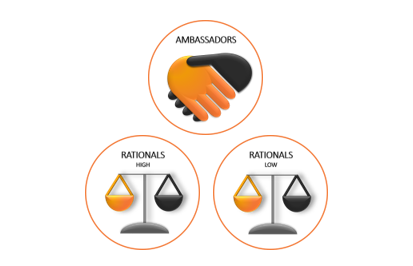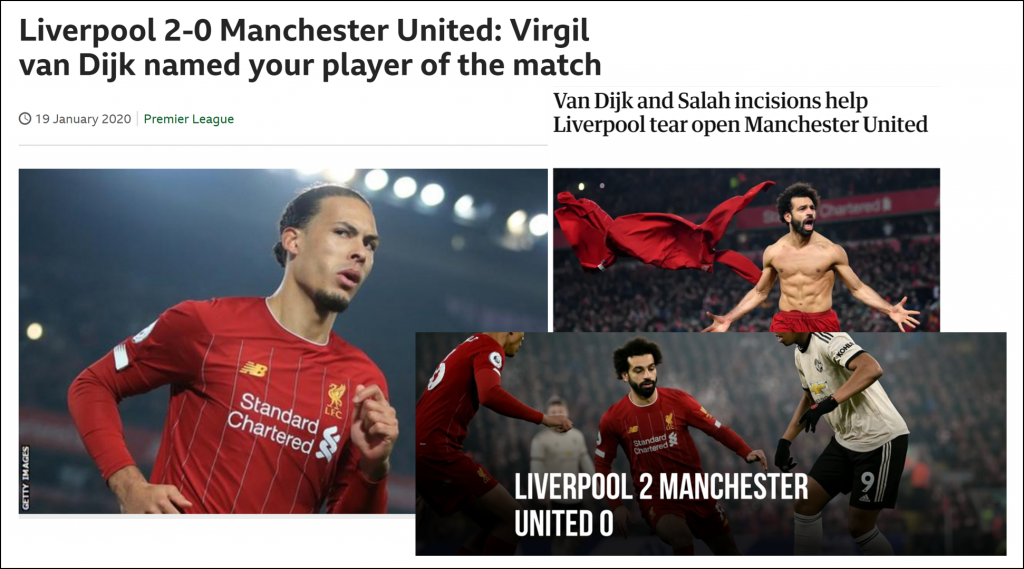Some time ago, we posted a blog called Help! What do I do with my Stalkers and Opponents? It was about the actions that account teams need to take with clients where there are very poor relationships. This blog is about the accounts with the best, strongest and deepest relationships. We call these clients Ambassadors.
Let’s start with a quick recap of the five B2B client categories that we use at Deep-Insight:
Customer Relationship Quality – the Strongest Relationships
The most loyal clients are Ambassadors. They are your most valuable customers. Ambassadors have a unique relationship with you and will recommend you to others. They are also prepared to pay a premium for your products or services. Price is not an important consideration for them because of the quality of the relationship. Typically, a third of most company’s B2B clients are Ambassadors.
The next segment of clients are known as Rationals. They rate you positively but do not see anything unique in the relationship. Rationals will assess alternative sources of supply and the relationship can become unstable if good alternative offers exist. Typically, half of your B2B accounts fit into this category. Generally they are good clients albeit not as loyal as Ambassadors.
The Weakest Relationships
But wait! That doesn’t add up to 100%. What’s the story with the others? Well, the answer is that in all B2B client portfolios, there are accounts and individuals that don’t love you. We typically find that 10-20% of accounts have poorer relationships with you and fit into one of the following three categories:
Ambivalents often have a “love/hate” relationship with you. In some instances, they love the way you solve their problems but hate the way you treat them. More often, you are killing them with kindness but failing to solve their business issues.
Stalkers are often only interested in price. Sometimes they can be large corporate accounts looking for discounts. Other times, they are smaller accounts with high service requirements and view your offering as poor value for money.
Opponents have the poorest relationships with you. They are deeply dissatisfied and often highly frustrated by what they see as consistently poor service.
Are ‘Ambassadors’ the same thing as ‘Promoters’?
If you use Net Promoter Score (NPS) as a performance metric, you’ll recognise the terms Promoters, Passives and Detractors.
Promoters are people who score you 9/10 or 10/10 when asked the question “Would you recommend [Company X] to a friend or colleague?” Passives score you 7 or 8. Detractors score you anywhere between 0 and 6.
Ambassadors are similar but here are the two crucial differences: First, an Ambassador is a company rather than an individual. Second, to become an Ambassador you have to get a good Net Promoter Score AND a good Customer Relationship Quality (CRQ) score. CRQ is our methodology for assessing the quality of B2B relationships and it is based on Trust and Commitment as well as some other factors, rather than Advocacy which is what the NPS metric is based on.
Think of it this way. Suppose you ask 20 people in a Key Account what they think of their relationship with you and would they be prepared to recommend you and your product or service. If the client is an Ambassador, 12 of the 20 individuals might be Promoters, six might be Passives and two might be Detractors. The overall relationship is great but there are still a couple of individuals who will not recommend you.
What do I do with my Ambassadors
For starters, sales and account teams should remember the following three things when they have an Ambassador client:
1. Recognise their importance and don’t take them for granted
The very first thing is to recognise that Ambassadors are generally your most profitable clients, for a number of reasons:
– They are typically less price-sensitive because they see what you offer as being unique.
– Ambassadors are generally willing to pay a premium for such uniqueness.
– Sales costs are lower. Less effort is required to extend existing contracts or negotiate new ones.
– There is less firefighting. Putting out fires can be expensive. Even when things go wrong, it’s generally easier to resolve operational issues with Ambassadors.
Don’t rest on your laurels. Don’t treat Ambassadors as cash cows. Invest time into the relationship to keep it fresh and exciting. It’s easy to get diverted to more problematic accounts where the shouting is the loudest. In our previous blog we talked about poor client relationships that are unprofitable. Unless there is a clear path to recovery, it is often better to re-allocate those resources to Ambassador clients where there is greater potential.
2. Ask them to recommend you
Remember that a high proportion of individuals in an Ambassador client are Promoters so they have already told you that they will recommend you. So take them up on the offer. Ask them for referrals. Those referrals could be the MDs of other divisions in the same company. This is important – it’s easier to expand your footprint in an existing client than to gain ‘new logo’ clients. Referrals could also be senior executives in other companies. Ask for testimonials or for case studies.
Trustmary is a Finnish company that helps clients do exactly that, by using Net Promoter Score as the key metric for identifying Ambassadors for their clients. Once the Ambassadors have been identified, Trustmary acquires testimonials in written or video format from those individuals.
Don’t be afraid to ask Ambassadors to talk at your next industry event or to be a guest speaker at your next conference. They want to help you. So just do it.
3. Start innovating and co-creating
As the account manager for an Ambassador client, you are probably in the enviable position of being a Trusted Advisor. You have the ear of the key decision makers in that account and the opportunity to bring new ideas and propositions to the table. Use that opportunity. Think of possible joint developments that you can do in partnership with the client. As well as adding more value and revenues, your next product line or service could result from such innovation or co-creation.
How many Ambassadors do you have?
The starting point for these decisions is an accurate and objective view of which category each of your major accounts fits into. Once you know that, you can start asking the right questions and taking the appropriate action.
Contact us if you want to find out how many Ambassadors you have!








